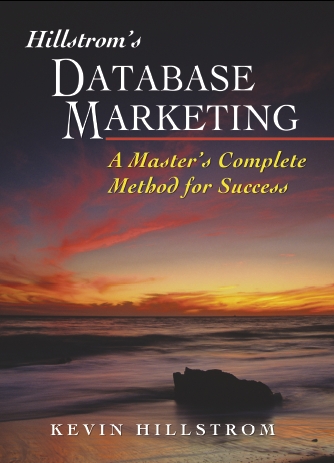Table Of Contents
Chapter 1: Introduction. A brief introduction to this book, where the topic of Customer File Dynamics will be discussed.
Chapter 2: The Life Table. This little-used technique clearly explains when customers leave your business. Historically, life tables were used in the field of Demography and in Actuarial Sciences. The math involved in a life table is simple to master. Results can easily be downloaded into a spreadsheet.
Chapter 3: Missing Data. Non-linear equations can be used to simulate what happens when you don't have complete data. Software freely available on the internet can be used to estimate relationships.
Chapter 4: Multi-Year Simulation. The future of a business can be measured by running a multi-year simulation. This chapter shows how a person named Jim Fulton used this technique to forecast business growth among specialty catalog titles at Lands' End. These techniques are easily entered into a spreadsheet. When applied properly, business leaders can clearly see where the future of their business is heading.
Chapter 5: Lifetime Value. Most textbooks have a very clinical approach to lifetime value. This chapter illustrates how the multi-year simulation can easily demonstrate the lifetime value of your customers. These techniques were used at Eddie Bauer in the late 1990s. Lifetime Value calculations have been around for decades. When viewed within the context of the multi-year simulation, Lifetime Value becomes very easy to measure.
Chapter 6: Experimental Design: Analytical techniques popularized before World War II are applied to advertising problems. In the mid 1990s, Lands' End used these techniques to fully understand how their specialty catalog titles interacted with each other.
Chapter 7: Rolling Twelve-Month File. This little-used method can help explain how a customer file changes as new stores, channels or products are introduced. The chapter explains methods used at Eddie Bauer, in the mid 1990s, to measure what happens when new stores are opened in new markets.
Chapter 8: Inter-File Dynamics. This is my favorite chapter in the book. The concepts of isolation, equilibrium, transfer and oscillation can be easily used to explain the interaction between products, channels, brands, or titles. Get your spreadsheet ready! In today's multi-channel world, techniques developed at Eddie Bauer in the mid 1990s are applied to today's business problems. In addition to being my favorite chapter, I believe the techniques outlined here have the most potential to teach all of us how our businesses are changing. Here is a brief description of the four customer file dynamics:
-
Isolation = A situation where the customers who purchase from a channel, brand or product classification stay loyal to that channel, brand or product classification. These customers are unlikely to try other channels, brands or products.
-
Equilibrium = A situation where customers freely shop other channels, brands or products. In general, customers are as equally likely to purchase from the last area they purchased from as they are to switch, and purchase from other areas of a business.
-
Transfer = The most interesting dynamic. In this situation, customers who purchase from on area of a business transfer their loyalty to another area of the business.
-
Oscillation = A unique situation where customers purchase from on area for awhile, then switch to another area of the business for a period of time.
Chapter 9: Visualizing Complex Information. Multi-Dimensional Scaling is used as a visualization tool to explore inter-file dynamics. A picture is worth a thousand words. A picture of a multi-dimensional scaling exercise is probably worth even more!
Chapter 10: Simulation. Remember the movie 'Apollo 13'? A simulator was used to get our crew back to Earth? The same concepts can be applied to your business. The future of Database Marketing is the application of simulation to our business problems.
Chapter 11: Analysis Recap. Results findings are outlined for the fictional business in this book, named 'Buddies'.
Chapter 12: Encouragement. Database Marketing professionals face many challenges in their day-to-day work. This chapter offers support to those who provide insight into how a business model works.
Editor's Comments
Kevinís new book, Hillstromís Database Marketing: A Masterís Complete Method for Success is published by Direct Academy, an imprint of Campbell & Lewis Publishers; 206 pages, hardcover, $95. The book is a complete and comprehensive consultation in database marketing principles for owners, CEOs, marketing executives, database coordinators, and the board of directors.
The publishers believe this is the finest book to be written on database marketing. It is clear. It is simple. It is understandable. It is complete. It is exactly what it promises: a masterís complete method for success. And Kevin Hillstrom is a Master of database marketing.
For the CEO, Hillstromís Database Marketing is a model for corporate database development or enhancement.
For the marketer, this book is a proven plan for improved performance, knowledge, profits and strategic wisdom.
For the newcomer to database marketer, this book will hold its own for decades as a primary textbook. It contains the knowledge of a successful Master and he is passing his science and his art to you for your future.
For the online, catalog, retail or wholesale entrepreneur, there is all the foundation 'How To' you need for building a database analytic process that creates success and growth.
For the financial manager, Hillstrom turns Ďmumbo jumboí into logical, clear data that translates to ROI and a higher corporate valuation and multiple.
For the Board of Directors, if your database marketing strategies and capabilities follow Hillstrom's methods, you can check off one less worry.
Hillstromís Database Marketing is destined to be a database marketing classic. Even better, for those few inside database pros who keep all the secrets to themselves, this book will be a cult classic.
